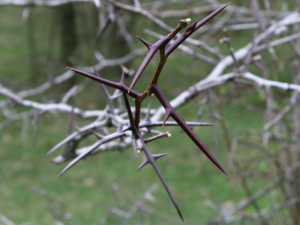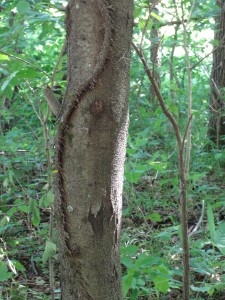It’s never been a good sign when the Forest Mulcher Guy turns off his Caterpiller engine, opens the cab and walks over to talk to me.
“You’ve got some pretty nice trees here.”
“…yes, but…”
“But you’ve also got some Honey Locust trees that need special attention.”
I had no idea what he was talking about, but I listened.

He explained that these trees have lots of thorns that are pretty much indestructible, are extremely sharp, and long enough to go right through a vehicle tire, or your boot, or anything that tries to walk over it. Big problem.
“The mulcher can’t grind up the thorns – they’re too small. If I try to grind them, I’ll just spread them all over the forest floor, waiting for you to step on them.”
“So what’s the solution?”
“We kill the tree with a hack and squirt, and then much later, after it is dead and the smaller branches have fallen off, we push it over with a bulldozer and drag it off, or burn it. That way you won’t have thorns everywhere.”

The idea of having long sharp thorns scattered around my forest bed was unappealing, but I wasn’t familiar with the “hack and squirt” technique. He explained that you take a hatchet and simply hack small cuts through the bark, encircling the tree. Then you squirt a potent root killer into the hacks. He recommended Tordon RTU (ready to use) as the herbicide.
The next time I was in the woods, I gave it a try.
My trusty Boy Scout hatchet was just the right size for hacking my way around the trunk, but I hesitated when I encountered the 2-inch thick Poison Ivy vine. Chopping through the vine seemed unwise. I envisioned Poison Ivy juice flying around while I flailed away the vine with my hatchet. I decided instead to skip over the vine. We’ll see how that plays out, but at least I wasn’t all rashed up from the Poison Ivy. The Tordon RTU was conveniently packaged in a small squeeze bottle, so I could dribble the poison directly into the chop marks.
